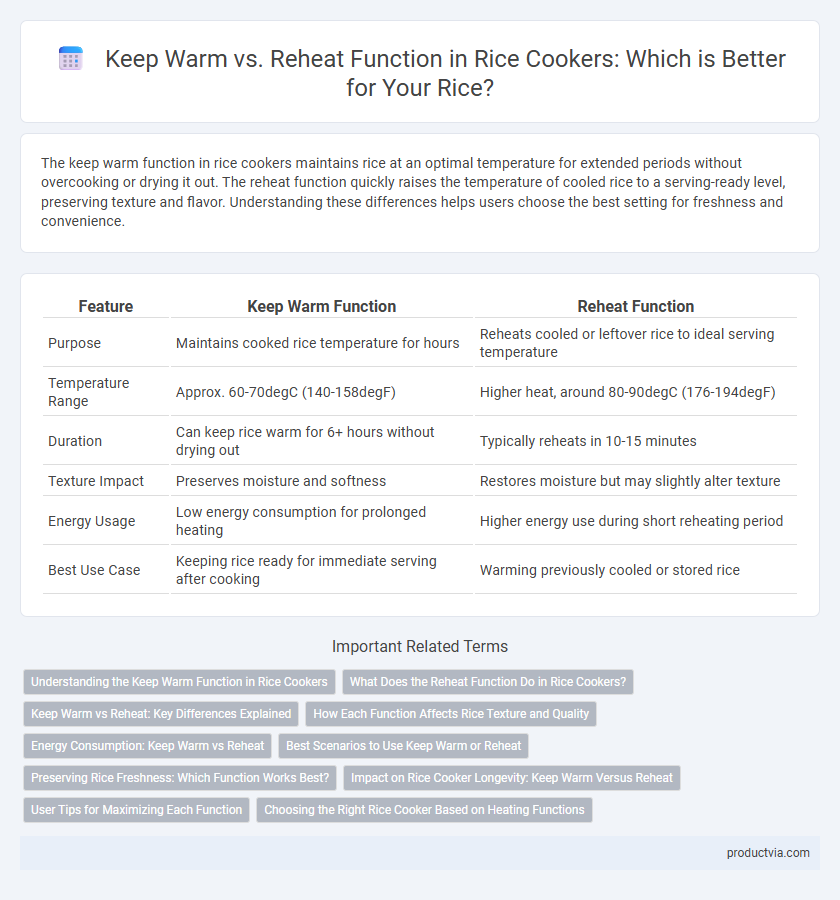The keep warm function in rice cookers maintains rice at an optimal temperature for extended periods without overcooking or drying it out. The reheat function quickly raises the temperature of cooled rice to a serving-ready level, preserving texture and flavor. Understanding these differences helps users choose the best setting for freshness and convenience.
Table of Comparison
| Feature | Keep Warm Function | Reheat Function |
|---|---|---|
| Purpose | Maintains cooked rice temperature for hours | Reheats cooled or leftover rice to ideal serving temperature |
| Temperature Range | Approx. 60-70degC (140-158degF) | Higher heat, around 80-90degC (176-194degF) |
| Duration | Can keep rice warm for 6+ hours without drying out | Typically reheats in 10-15 minutes |
| Texture Impact | Preserves moisture and softness | Restores moisture but may slightly alter texture |
| Energy Usage | Low energy consumption for prolonged heating | Higher energy use during short reheating period |
| Best Use Case | Keeping rice ready for immediate serving after cooking | Warming previously cooled or stored rice |
Understanding the Keep Warm Function in Rice Cookers
The Keep Warm function in rice cookers maintains cooked rice at an optimal temperature, typically between 60degC to 70degC, preventing bacterial growth while preserving texture and moisture. This function continuously supplies low heat without cooking the rice further, ensuring it remains soft and ready to serve for several hours. Understanding this feature helps users avoid drying out or overcooking rice, unlike the Reheat function, which actively warms cooled rice to serving temperature.
What Does the Reheat Function Do in Rice Cookers?
The reheat function in rice cookers quickly warms rice to an optimal serving temperature without overcooking or drying it out. This feature uses controlled low heat to evenly restore moisture and texture, preserving the rice's original quality after cooling. Unlike the keep warm function, which maintains rice temperature for extended periods, reheating is a short, targeted process designed to refresh the rice just before serving.
Keep Warm vs Reheat: Key Differences Explained
The Keep Warm function in rice cookers maintains cooked rice at a safe, consistent temperature to preserve texture and prevent spoilage without further cooking. Reheat mode, on the other hand, quickly raises the temperature of cooled rice to serving warmth, often using higher heat settings that can affect moisture levels. Understanding these key differences helps optimize rice quality and energy efficiency based on immediate consumption needs.
How Each Function Affects Rice Texture and Quality
The keep warm function maintains rice at a consistent low temperature, preserving its moisture and preventing overcooking, which helps retain a fluffy and tender texture. The reheat function, typically using intermittent bursts of heat, can dry out the rice slightly and cause a firmer, sometimes uneven texture due to the rapid temperature changes. Understanding these differences allows users to optimize rice quality by choosing keep warm for maintaining freshness over time and reheat for short-term temperature restoration.
Energy Consumption: Keep Warm vs Reheat
The Keep Warm function in rice cookers consumes less energy by maintaining a low, steady temperature to prevent rice from cooling, whereas the Reheat function uses a higher energy burst to raise the temperature of already cooled rice quickly. On average, Keep Warm mode operates at about 20-40 watts, while Reheat mode can spike to 200-300 watts during activation. Opting for Keep Warm over Reheat reduces overall energy consumption and improves energy efficiency during extended use.
Best Scenarios to Use Keep Warm or Reheat
The keep warm function in rice cookers is ideal for maintaining the optimal serving temperature of freshly cooked rice without overcooking or drying it out, making it perfect for meals served over a short period. The reheat function is best used when rice has cooled and requires gentle warming to restore texture and moisture without burning or hardening. Use keep warm during meal times for consistent heat and reheat when serving leftovers to achieve better taste and quality.
Preserving Rice Freshness: Which Function Works Best?
The Keep Warm function in rice cookers maintains a low, consistent temperature to preserve rice freshness without overcooking or drying it out, extending its edible period up to 12 hours. The Reheat function, designed to quickly warm cooled rice, can alter texture by causing uneven heating and potential moisture loss, making it less ideal for long-term freshness preservation. For maintaining optimal taste and texture, the Keep Warm setting is generally the best option to keep rice fresh and ready to serve.
Impact on Rice Cooker Longevity: Keep Warm Versus Reheat
Using the Keep Warm function in rice cookers maintains rice at a safe temperature without subjecting the heating element to frequent temperature fluctuations, thereby enhancing the appliance's longevity. The Reheat function causes repeated heating cycles that can strain internal components and reduce the rice cooker's lifespan over time. Consistently relying on Keep Warm instead of Reheat preserves the integrity of heating elements and optimizes overall durability.
User Tips for Maximizing Each Function
To maximize the Keep Warm function, set it immediately after cooking to maintain rice at an optimal temperature without drying out, ideally for up to 12 hours to prevent spoilage. Use the Reheat function to evenly warm refrigerated rice by adding a small amount of water before reheating, which helps restore moisture and texture. Avoid repeatedly switching between functions to preserve rice quality and prevent overcooking or dryness.
Choosing the Right Rice Cooker Based on Heating Functions
Choosing the right rice cooker depends significantly on its heating functions, specifically the keep warm and reheat settings. Keep warm maintains rice at a consistent temperature to prevent it from cooling and drying out, ideal for serving later without recooking. The reheat function actively warms cooled rice, restoring moisture and texture without overcooking, essential for users who store and consume rice throughout the day.
Keep warm vs reheat function for rice cookers Infographic

 productvia.com
productvia.com